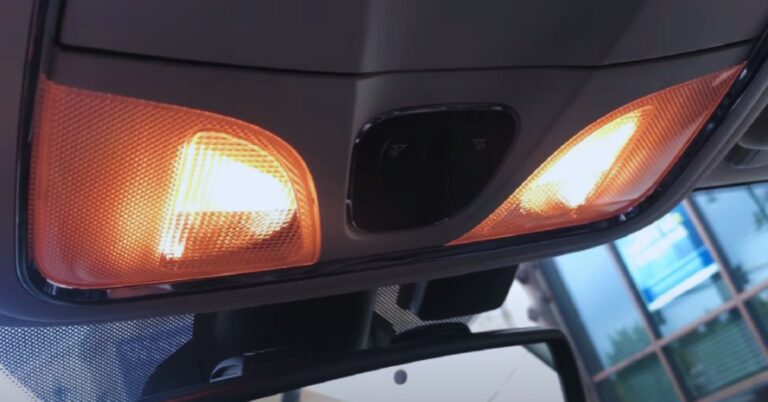Aux Switches Temporarily Unavailable Battery Charging- Why & How To Fix?
Ever puzzled over the “Aux Switches Temporarily Unavailable Battery Charging” error? Wondering what triggers this message and how to fix it? Don’t worry anymore as we are here to help you out.
The error pops up when the main or auxiliary battery is not fully charged or is unable to maintain the charge. This could happen for several reasons like low or dying auxiliary/main battery or fuse or other electrical issues.
However, that’s not all for you to know to fix the problem. No worry as here we will comprehensively discuss the reasons and the possible fixes. So, just keep on reading.
Key Takeaways
- Regularly check battery condition and voltage to prevent the error.
- Swiftly resolve issues like failing batteries, alternator problems, or blown fuses to maintain optimal electrical system function.
- Given modern vehicles’ constant electrical draw, replace both batteries every 3-5 years to prevent unexpected failures and ensure vehicle reliability.
What Does The Error Message Mean?
When you see the message “Auxiliary switches temporarily unavailable battery charging,” it means that your Jeep’s auxiliary switches, which control additional electrical accessories, are currently disabled to preserve battery power for charging.
This message typically appears when the vehicle’s charging system is active, prioritizing the replenishment of the battery over the operation of auxiliary switches to prevent draining the battery further. It’s a protective measure to ensure that your Jeep’s battery has enough power to start the engine and operate essential systems.
Why The Aux Switches Temporarily Unavailable Battery Charging Error Pops Up? [Reasons + Fixes!]
Well there are a number of reasons that can cause the error message to pop up on the dashboard like auxiliary battery or the main battery is going out or the others. However, let’s discuss the details below.
1# Auxiliary Battery Is Going Out
The error message can be triggered when the auxiliary battery, responsible for powering the auxiliary switches, experiences degradation or depletion. Over time, the auxiliary battery’s capacity diminishes due to factors such as age, usage, and environmental conditions.
When the auxiliary battery’s voltage drops below a certain threshold, the Jeep’s charging system prioritizes recharging it to maintain essential electrical functions, such as starting the engine and powering critical systems.
Consequently, the system temporarily disables the auxiliary switches to conserve power for battery charging, resulting in the appearance of the error message.
How To Fix:
Here is how you can replace the auxiliary battery.
- Step 1: Locate the auxiliary battery in your Jeep. It’s usually found near the main battery but might be in a different location depending on your vehicle model.
- Step 2: Use a multimeter or have a technician test the auxiliary battery to determine if it’s failing or depleted. Look for signs of corrosion or damage on the battery terminals.
- Step 3: If the auxiliary battery is indeed going out, purchase a new one that matches the specifications of your Jeep’s electrical system.
- Step 4: Disconnect the old auxiliary battery by removing the cables, then install the new battery and reconnect the cables securely.
2# Low Or Dying Battery
A low or dying main battery triggers the vehicle’s charging system to prioritize battery charging over auxiliary switch operation. Factors such as age, usage patterns, and extreme temperatures can contribute to the deterioration of the main battery’s capacity.
When the main battery’s voltage drops below a certain threshold, the vehicle’s electrical system shifts its focus to recharging the battery, temporarily disabling auxiliary switches to conserve power.
Regular battery maintenance is essential to prevent this issue and ensure optimal electrical system performance.
How To Fix:
Check out the below troubleshoots to fix the issue.
- Check the Battery Voltage:
Using a multimeter, measure the voltage of the main battery with the key turned on. Ideally, the voltage should be around 12.6 volts. If it’s significantly lower, the battery may need attention.
- Jumpstart or Recharge the Battery:
If the battery voltage is low, jumpstart the vehicle using jumper cables and another vehicle with a fully charged battery. Alternatively, use a battery charger to recharge the battery.
- Replace the Battery if Necessary:
If the battery fails to hold a charge or consistently shows low voltage readings despite charging, it may be time to replace it. Choose a replacement battery that meets the specifications of your Jeep’s electrical system.
3# Alternator Issues
An alternator malfunction can lead to insufficient charging of the main battery, triggering the system to disable auxiliary switches to conserve power.
The alternator is responsible for generating electrical power to recharge the battery and power the vehicle’s electrical systems while the engine is running.
How To Fix:
Below are the fixes for resolving the issue.
- Use a multimeter to test the output voltage of the alternator while the engine is running. Ideally, the voltage should be around 13.5 to 14.5 volts.
- Ensure the alternator belt is properly tensioned and in good condition. Inspect the electrical connections to the alternator for signs of corrosion or looseness.
- If the alternator output voltage is significantly lower than the recommended range or fluctuates erratically, it may indicate a faulty alternator.
- If the alternator is found to be faulty, replace it with a new or refurbished unit that meets the specifications of your Jeep’s electrical system.
4# High Amp Fuse Problem
A blown high amp fuse can disrupt the charging system, leading to the temporary unavailability of auxiliary switches during battery charging.
High amp fuses are designed to protect electrical circuits from overloads and short circuits, and when one blows, it interrupts the flow of electricity to critical components, including the charging system.
How To Fix:
Replace the blown fuse with a new one of the correct amperage. Here is how:
Step 1: Locate the Fuse Box:
Consult your Jeep’s manual to find the location of the fuse box containing the high amp fuses. It’s typically located in the engine compartment or under the dashboard.
Step 2: Identify the Blown Fuse:
Inspect the high amp fuses visually or use a multimeter to identify the one that has blown. A blown fuse will have a broken wire or a visibly burnt appearance.
Step 3: Select the Correct Replacement Fuse:
Choose a replacement fuse with the same amperage rating as the one you removed. Using a fuse with the wrong amperage rating can lead to electrical issues or damage to components.
Step 4: Replace the Fuse:
Carefully remove the blown fuse and insert the new one into its slot. Ensure it’s seated securely to maintain proper electrical connections.
5# Other Electrical Issues
Various other electrical issues beyond those mentioned above could trigger the error message. These issues may include faulty wiring, malfunctioning relays, or other components within the vehicle’s electrical system.
How To Fix:
To fix the problem conduct comprehensive diagnostic testing using specialized equipment to identify specific electrical issues within the vehicle’s system. This may involve testing individual components, checking wiring integrity, and inspecting connections.
Consult a qualified technician or automotive electrician to perform a thorough inspection of the vehicle’s electrical system.
What If the ‘Aux Switches Temporarily Unavailable Battery Charging’ Error Comes After Replacing The Battery
First things first, check the battery and fuses. Make sure the battery shows about 12.6 volts with the key turned on.
If the battery seems weak, jumpstart it or recharge it. Then, with the ignition on, look at all the fuses in the vehicle. If any of them look burnt out or broken, replace them.
If it does not work out, try out the below fixes.
1# Check The Trouble Codes
After replacing the battery, it’s essential to check for any stored trouble codes in the vehicle’s onboard diagnostic system.
These codes can provide valuable insight into any underlying issues that may be causing the error message to persist.
Common trouble codes related to electrical issues or battery management system faults may be stored in the system.
How To Fix:
Check out the below steps.
- Use an OBD-II diagnostic scanner to retrieve any stored trouble codes from the vehicle’s onboard computer system.
- Interpret the trouble codes displayed on the scanner’s screen or refer to a code lookup guide to understand their meanings. Pay particular attention to codes related to battery management, electrical system faults, or auxiliary switch functionality.
- Based on the trouble codes retrieved, diagnose and address any underlying issues indicated by the codes. This may involve repairing faulty components, resolving wiring issues, or resetting the battery management system, as necessary.
- After addressing the identified issues, use the diagnostic scanner to clear any stored trouble codes from the vehicle’s computer system. This ensures that any previous fault codes are no longer present and allows for a fresh start in monitoring the vehicle’s electrical system.
Make sure to utilize a dealership-level scan tool or a Snap On/Mac Tools type scanner for optimal outcomes. It should be bi-directional to effectively communicate with and retrieve codes from all of the vehicle’s computers.
2# Battery Management System Reset
The battery management system (BMS) is responsible for monitoring and managing the charging and discharging of the vehicle’s battery.
Resetting the BMS can recalibrate its settings and parameters, ensuring proper communication and functionality with the battery.
This process can help clear any stored fault codes or erroneous data that may be causing the error message to persist.
How To Fix:
Follow up the below steps.
- Step 1: Consult your vehicle’s manual or contact a dealership for specific instructions on how to perform a BMS reset. The procedure may vary depending on the make and model of your vehicle.
- Step 2: Follow the steps outlined in the vehicle’s manual or provided by the dealership to reset the BMS. This typically involves a series of steps such as turning the ignition key to certain positions or using specific buttons or controls in a particular sequence.
- Step 3: Allow the BMS reset procedure to complete fully before attempting to start the vehicle or operate any electrical systems.
3# Reset The Computers
Resetting the vehicle’s onboard computer systems can clear any stored fault codes or erroneous data, providing a fresh start for monitoring the vehicle’s electrical system.
This process can help ensure proper communication and functionality following the replacement of the battery or when troubleshooting electrical issues.
How To Fix:
Follow the below steps to reset the computers.
- Use Diagnostic Tool:
If you’re not seeing any fault codes and all of the computers are online, consider resetting the computers using a diagnostic scan tool.
- Disconnect Battery Cables:
Alternatively, manually reset the computers by disconnecting both of the battery cables from the battery. Start by disconnecting the ground cable (negative) first, followed by the positive cable.
- Touch Cable Ends Together:
After disconnecting the battery cables, touching the cable ends together for approximately 2 minutes. This helps discharge any residual power and clears the capacitors in the vehicle’s electrical system.
- Reconnect Battery Cables:
After the 2-minute period, reconnect the battery cables in the reverse order: positive cable first, followed by the ground cable. Ensure the cables are securely tightened.
- Retest Vehicle Operation:
Start the vehicle and allow it to idle for a few minutes to allow the onboard computer systems to initialize and recalibrate.
Monitor the vehicle for any recurrence of the error message and verify that the auxiliary switches are functioning properly.
FAQs
Now let’s get to know the answer to some queries that are mostly asked by the jeep owners about the matter. You can learn from them to know more.
Why does my Jeep display the “Auxiliary switches temporarily unavailable battery charging” message?
This message appears when the charging system prioritizes battery charging. Possible causes include a failing auxiliary battery, low main battery charge, alternator issues, or blown fuses.
What should I do if I see the error message?
Check battery voltage, inspect fuses, jumpstart or recharge the battery. Reset the battery management system or onboard computers if needed. Consult a technician if the issue persists.
Is it safe to drive when the error message appears?
Address the issue promptly. Avoid using auxiliary switches. If unsure, seek professional assistance from a technician to ensure the vehicle’s electrical system functions correctly and avoid potential safety hazards.
Final Words
Well that’s all! Hope you get what it will take to resolve the issue. The tough truth is both batteries need replacement together.
When the auxiliary battery fails, it often causes the main battery to fail too, which usually doesn’t have much life left.
Batteries usually last 3-5 years, but now it’s closer to 3 due to modern vehicles’ constant electrical use. These vehicles have many electronics that are always on, draining the batteries.
It’s essential to replace both batteries every few years to keep your vehicle running smoothly.




